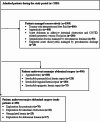Predictive value of various nutritional assessment scores for Short-term outcomes after emergency abdominal surgery: A prospective cohort study
- PMID: 40788397
- PMCID: PMC12339590
- DOI: 10.1007/s00068-025-02943-2
Predictive value of various nutritional assessment scores for Short-term outcomes after emergency abdominal surgery: A prospective cohort study
Abstract
Background: Various nutritional assessment scores have been validated and accepted as predictors of postoperative outcomes in elective surgery. The objective of this study was to assess prospectively the predictive value of three of these scores (the CONUT score, the PNI, and the NRI) for short term outcomes following emergency abdominal surgery.
Patients and methods: This is a prospective cohort study that was conducted over a period of 13 months. It was approved by the local ethical committee and included 150 patients who underwent emergency major abdominal surgeries and agreed to participate in the study. All patients included were clinically assessed and underwent laboratory and radiological investigations based on their presentation. Data required to calculate the three nutritional indices were collected. Patients underwent their specific surgery and received postoperative care in either the surgical ICU or surgical ward according to standard protocols based on the type of surgery.
Results: Males comprised 64.70% of the study populations with a mean age of 48.48 ± 15.80 years and a mean BMI of 29.55 ± 4.99 kg/m2. The preoperative diagnosis was peritonitis due to various etiologies in 50.7% of patients, while 21.3% were diagnosed with intestinal obstruction. According to the CONUT score, the preoperative nutritional status was normal in 43.3% of patients. mild malnutrition in 46%, moderate malnutrition in 10.7%, and no patients with severe malnutrition. The PNI values ranged from 32.4 to 59.5 with a mean of 46.76 ± 6.55 while the NRI values ranged from 33.8 to 49.9 with a mean of 46.94 ± 1.90. The NRI had the highest diagnostic accuracy at 73%, followed by the CONUT score at 68%, and lastly the PNI at 66%.
Conclusion: The three nutritional assessment scores were significant predictors of postoperative complications in emergency abdominal surgery, with the NRI showing the highest diagnostic accuracy.
Keywords: Abdominal surgery; Emergency; Nutritional assessment scores; Outcomes; Predictive value.
Conflict of interest statement
Declarations. Ethics approval and consent to participate: The study was approved by the Ethical Committee of Tanta University Hospitals in Tanta, Egypt (approval code: 34229/11/20). All participating patients provided informed written consent. This research was conducted in accordance with the Declaration of Helsinki. Competing interests: The authors declare no competing interests.
Figures
Similar articles
-
The Global Leadership Initiative on Malnutrition criteria for diagnosis of malnutrition and outcomes prediction in emergency abdominal surgery.Nutrition. 2024 Mar;119:112298. doi: 10.1016/j.nut.2023.112298. Epub 2023 Nov 4. Nutrition. 2024. PMID: 38176361
-
Prognosis and assessment of the predictive value of severity scores in paediatric abdominal trauma: A French national cohort study.Eur J Anaesthesiol. 2024 Sep 1;41(9):632-640. doi: 10.1097/EJA.0000000000002019. Epub 2024 May 20. Eur J Anaesthesiol. 2024. PMID: 38769943
-
Assessment of nutritional indices for predicting clinical outcomes in critically ill elderly patients: a prospective cohort study.BMC Anesthesiol. 2025 Jul 28;25(1):359. doi: 10.1186/s12871-025-03232-6. BMC Anesthesiol. 2025. PMID: 40721987 Free PMC article.
-
The comparative and added prognostic value of biomarkers to the Revised Cardiac Risk Index for preoperative prediction of major adverse cardiac events and all-cause mortality in patients who undergo noncardiac surgery.Cochrane Database Syst Rev. 2021 Dec 21;12(12):CD013139. doi: 10.1002/14651858.CD013139.pub2. Cochrane Database Syst Rev. 2021. PMID: 34931303 Free PMC article.
-
Predictive factors affecting outcome after cervical laminoplasty.Spine (Phila Pa 1976). 2013 Oct 15;38(22 Suppl 1):S232-52. doi: 10.1097/BRS.0b013e3182a7eb55. Spine (Phila Pa 1976). 2013. PMID: 23962999
References
-
- Leide da Silva Nunes F, Calado Ferreira Pinheiro Gadelha P, Damasceno de Souza Costa M. Carolina Ribeiro de Amorim AC, Bezerra da Silva Mda G. Nutritional status and its impact on time and relocation in postoperative complications of abdominal patients undergoing surgery. Nutr Hosp. 2014;30(3):629– 35. 10.3305/nh.2014.30.3.7628 - PubMed
-
- Correia MI, Waitzberg DL. The impact of malnutrition on morbidity, mortality, length of hospital stay and costs evaluated through a multivariate model analysis. Clin Nutr. 2003;22(3):235-9. 10.1016/s0261-5614(02)00215-7 - PubMed
-
- Thomas MN, Kufeldt J, Kisser U, Hornung HM, Hoffmann J, Andraschko M, Werner J, Rittler P. Effects of malnutrition on complication rates, length of hospital stay, and revenue in elective surgical patients in the G-DRG-system. Nutrition. 2016;32(2):249–54. Epub 2015 Sep 25. PMID: 26688128. - PubMed
-
- Iseki Y, Shibutani M, Maeda K, Nagahara H, Ohtani H, Sugano K, Ikeya T, Muguruma K, Tanaka H, Toyokawa T, Sakurai K, Hirakawa K. Impact of the preoperative controlling nutritional status (CONUT) score on the survival after curative surgery for colorectal cancer. PLoS One. 2015;10(7):e0132488. 10.1371/journal.pone.0132488. PMID: 26147805; PMCID: PMC4492767. - PMC - PubMed
-
- Okamura Y, Ashida R, Ito T, Sugiura T, Mori K, Uesaka K. Preoperative neutrophil to lymphocyte ratio and prognostic nutritional index predict overall survival after hepatectomy for hepatocellular carcinoma. World J Surg. 2015;39(6):1501–9. 10.1007/s00268-015-2982-z. - PubMed
LinkOut - more resources
Full Text Sources





